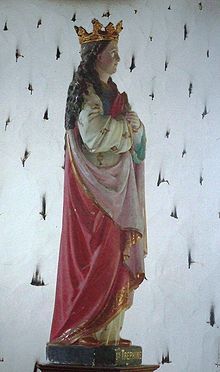- Conomor
-
Conomor (fl. c. 540+), also known as Conomerus or Conomor the Cursed, was an early medieval ruler of Brittany. His name, which has the Welsh cognate Cynfawr, means "Great Dog", but could also indicate "Sea Dog" in early Brythonic. Conomor was notorious for his cruelty, becoming a legendary villain in Breton culture. He is widely regarded as one of the probable sources for the myth of Bluebeard and possibly also of Tristan's uncle King Mark of Cornwall. The wife-beating giant Cormoran may also retain a garbled folk memory of the same character.
Conomor was king of Domnonée, which at this time was expanding to claim control over all Brythonic territory in Armorica (Brittany). It is difficult to disentangle the Conomor of legend from the historical ruler. As with other early Breton rulers most written information about him comes from the lives of Breton saints.
Contents
Historical record
Conomor is mentioned in Cornish genealogies, and may have established himself in Brittany after a youth in Cornwall, i.e. Dumnonia. He is mentioned by Gregory of Tours as a Breton count; he is listed as "prefectus du roi des Francs" in the life of Saint Tugdual and in the life of Saint Paul Aurelian he is called ruler of "different peoples of four languages", which may suggest that his territory included both Brittany and Cornwall.[1] Conomor is said to been count of Carhaix and to have become king by murdering his predecessor Jonas. He married Jonas' widow, but she later fled from him to seek asylum in the Frankish court with her son Judael. He is later said to have come into conflict with Waroch, count of Vannes, whose daughter Tréphine he had married after his first wife's death. In unclear circumstances he is said to have murdered Tréphine and later his son by her, Trémeur.[1]
Eventually the local bishops were persuaded by Saint Samson to excommunicate Conomor. Samson also prevailed on the Frankish king Childebert I to abandon his support for Conomor as protector of the English channel and to release Judael. Judael gathered an army supported by Childebert's brother Chlothar I and killed Conomor in a battle in the Monts d'Arrée near Le Relecq, Plounéour-Ménez, which is named from the relics of the victims.[2]
The Tristan Stone near Fowey records the burial of a 'Drustanus son of Conomorius' - see below.
The Cynfawr (Conomor) of medieval Welsh tradition is probably unrelated. An obscure figure with the epithet "Cadgaddug" ("Battle-winner"), he appears in the genealogies and one of the Welsh Triads as a descendant of Coel Hen from the Hen Ogledd.[3] It is also unclear whether Cornish evidence points to the same individual as the Breton leader, or to an earlier relative with the same name.[4]
In legend
Myth of Tréphine and Trémeur
In legend Conomor's villainy is extended to include the murders of three wives before Tréphine. Tréphine refuses to marry him because of his reputation, but when he threatens to invade her father's lands she agrees, to spare the lives of her father's people. While Conomor is away Tréphine finds a secret room containing relics of the deceased wives. She prays for their souls, and their ghosts appear to her warning her that Conomor will kill her if she becomes pregnant, since a prophecy states that he will be killed by his own son. When he returns he discovers that she is pregnant. Tréphine escapes with magical aid from the dead wives and gives birth in a forest. She hides her son before Conomor catches her and beheads her. However Saint Gildas finds her and miraculously restores her to life. She and her son both live lives of saintly retirement, but after Tréphine's death Conomor eventually finds Trémeur and kills him.
Both Tréphine and her son Trémeur are deemed saints in Brittany, and there are many churches dedicated to them. The village of Sainte-Tréphine is named for the former.[2] It has been suggested that the story of Bluebeard derives from this myth.[5]
Myth of Tristan
An inscription in Cornwall which includes the names of Conomor and Tristan has led to the suggestion that Conomor is the origin of the figure of King Mark in the Tristan legend. It states "Drustanus hic jacit cunomori filius" (here lies Tristan, son of Conomor). The historian Léon Fleuriot argues that Conomor probably held sway in both Britain and Brittany:
He is often presented as a vassal of Childebert: a praefectus, said the Chronicle of Saint Brieuc: "Comorus tyrannus, praefectus Francorum regis." Comonor appears to have been a Britto-Roman. The Life of St. Paul refers to "king Marc", or princeps Marc, or, in his full name, Marcus Quonomorius.[6]
The writer Jean Markale developed this argument, suggesting that the Tristan legend originated in Ireland, but that the names of the characters derive from actual people in Cornish history whose lives involved "the rivalry of a father and son for the same woman", the father being Conomor/Mark and the son Tristan.[7] However, it has also been argued that this Cornish Conomor was probably the Breton leader's great grandfather.[4]
References
- ^ a b George Minois, Nouvelle Histoire de la Bretagne, Fayard, 1992, p182
- ^ a b Wendy Mewes, Discovering the History of Brittany, Red Dog, 2006, p. 44
- ^ Rachel Bromwich (ed.), Trioedd Ynys Prydein (University of Wales Press, 1961; revised ed. 1991), p. 322
- ^ a b Conomor, King of Dumnonia
- ^ Gilles Rihouay, Konomor, Barbe-bleue breton, Éd. Keltia Graphic, 29540 Spézet, 2001
- ^ Léon Fleuriot, Les Origines de la Bretagne, p. 189.
- ^ Jean Markale, Histoire secrète de la Bretagne, Albin Michel, Paris, 1977, p.96
Categories:- History of Brittany
- People from Cornwall
- Breton people
Wikimedia Foundation. 2010.

